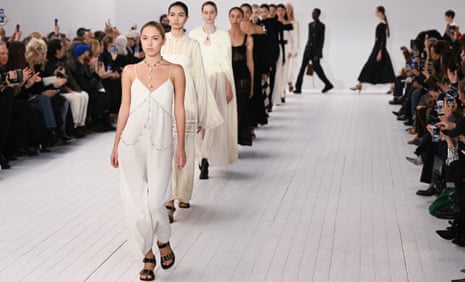The real passion of Gabriela Hearst, the creative director of the Parisian house of Chloé, is sustainability, not fashion. But she works in a luxury business where clothes and handbags pay bills and salaries. Can she balance the books between the environmental and business bottom lines?
It is this question, rather than what length skirts should be this season, that keeps Hearst up at night. “I never think about trends. If I hit a trend it’s a complete accident. I inherited my mum’s wardrobe, my daughters take their denim from me. Quality is everything. People ask why my clothes cost so much. It is because the fabric and construction will last your lifetime and beyond.”
Hearst landed the Chloé job two years ago, after making her name with a niche eponymous brand that schooled the 1% in the joys of deadstock fabric and cashmere recycling. Her mission at Chloé is to scale up aspirational sustainable fashion, and pull it off on the industry’s biggest stage, Paris fashion week.

“This is my favourite collection I’ve done for Chloé so far,” Hearst said backstage before the show.
She was wearing a double-breasted linen jacket, which was about to make its catwalk debut, finished with hammered gold buttons made by a social enterprise project in Kenya that provides artisans in impoverished communities with opportunities to work with global fashion brands.
The Chloé supermodel this season is the painter Artemisia Gentileschi – born 1593 – one of the few women who found success in the male-dominated world of Renaissance art.
“The climate emergency will need lots of different solutions, there’s no single answer. Female leadership is intrinsic to that path because women excel at elevating other people.”
The modern world needs to rediscover the spirit of the Renaissance, said Hearst, because “it is the artists and the scientist who will get us out of this mess – I don’t put too much faith in the politicians”.
Gentileschi loved clothes – she was known to incur debts by placing lavish orders for taffeta beyond her means – and the pearl earrings, portrait necklines and bishop sleeves on the catwalk could have stepped direct from her canvas. Capes and graphic silk ribbon striped suits also had a courtly air, but slinky cream ribbed dresses and black leather outerwear were thoroughly modern.
Hearst rejects the modish view of “vegan” leather as an environmentally friendly choice. “For as long as we are eating meat, leather is a byproduct of that,” she argued.
“So it is a good fabric to use. When I go home to my ranch in Uruguay they ask me – what’s happening in the north? They are having to burn leather, because people want to wear polyester instead. The idea that vegan shoes are helping the environment is just good marketing.”
New this season are QR codes in each garment, which identify and authenticate each piece, designed to facilitate and encourage a circular economy. In theory, they act as an invisible, everlasting version of the swing tags that hang in Chloé boutiques, so that the garment retains the cachet it had on the shop floor of a Chloé boutique, however many times it changes hands.
Secondhand shoppers will be reassured that a piece is genuine while women with Chloé clothes hanging in their wardrobes unworn will be motivated to sell those clothes on if they retain value.
Hearst and label CEO Riccardo Bellini are awaiting the result of profit-and-loss audits on the environmental and social impact of the company, which will measure the extent to which Chloé has succeeded in lowering its carbon footprint.
Bellini admits that there is a “constant trade-off” between Chloé’s business aspirations and its principles. Some 60% of fabrics used are “lower impact” materials, and Chloé no longer sells cotton T-shirts, to avoid the water-intensive production of that fabric.
Cashmere has been replaced by recycled cashmere, and denim by circular denim, which is made of a mix of recycled cotton and either hemp or linen.
But Hearst admits that, as a designer, she does not want customers to stop shopping. “My self-esteem is attached to sell-through,” she told Womenswear Daily recently.




